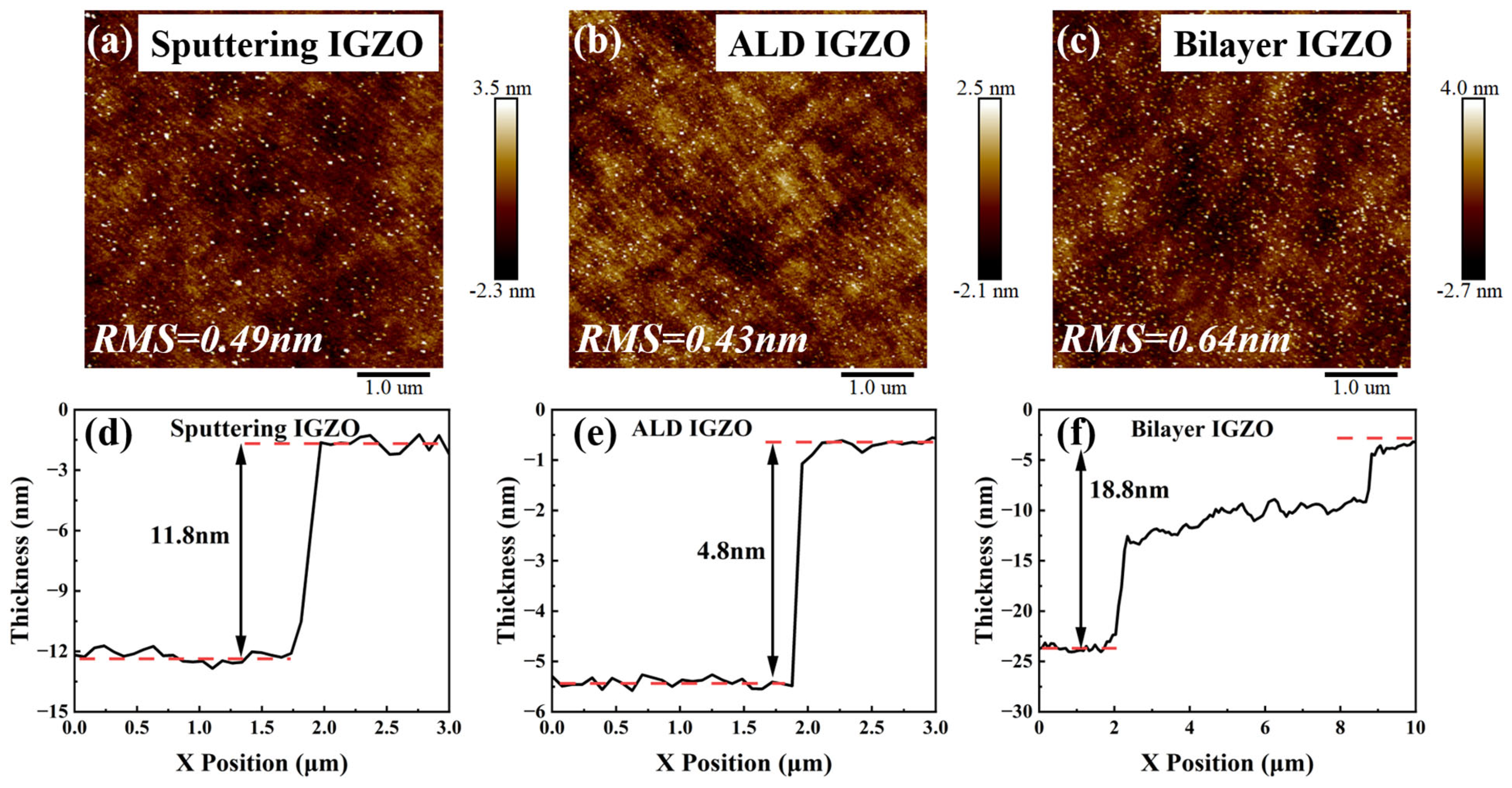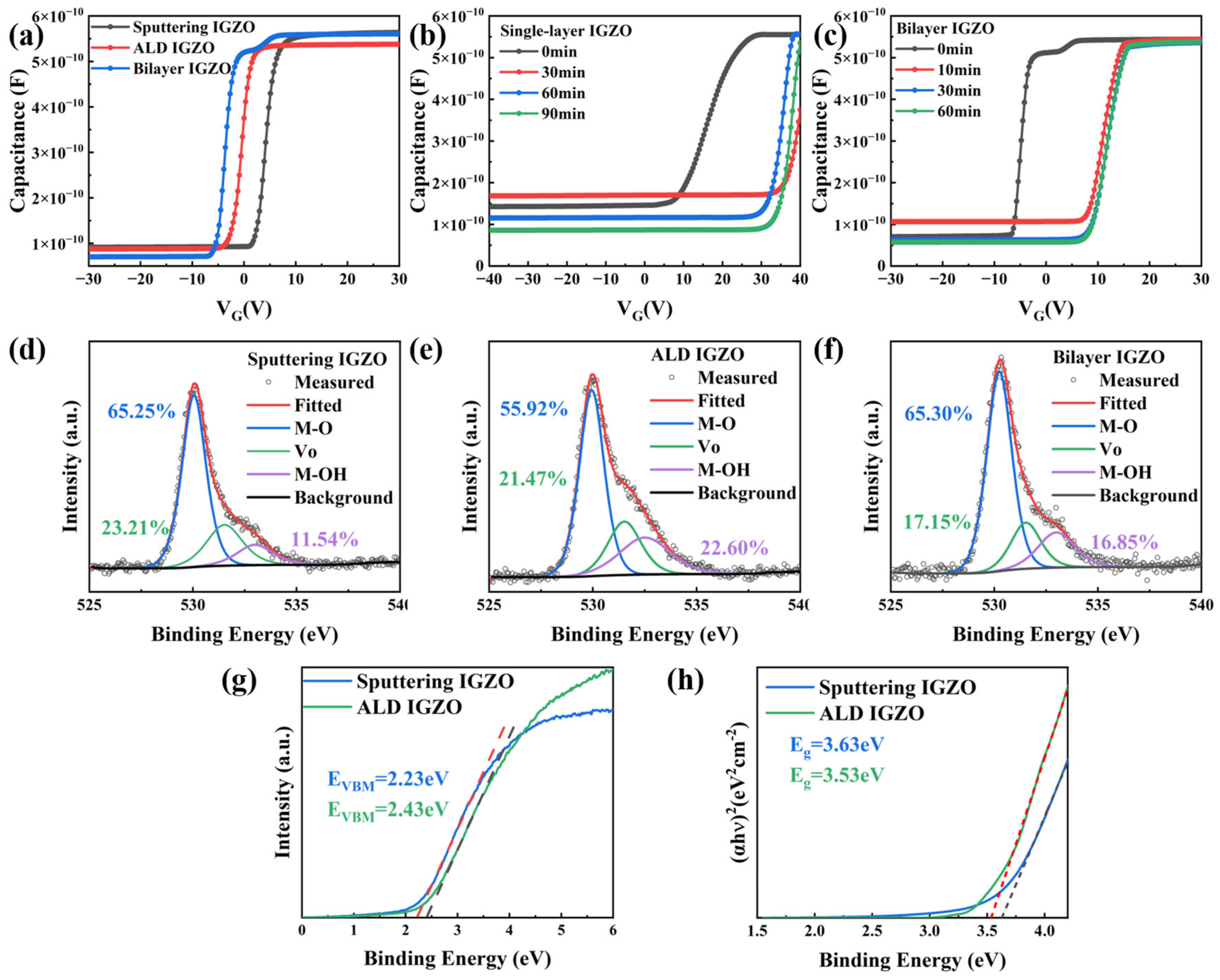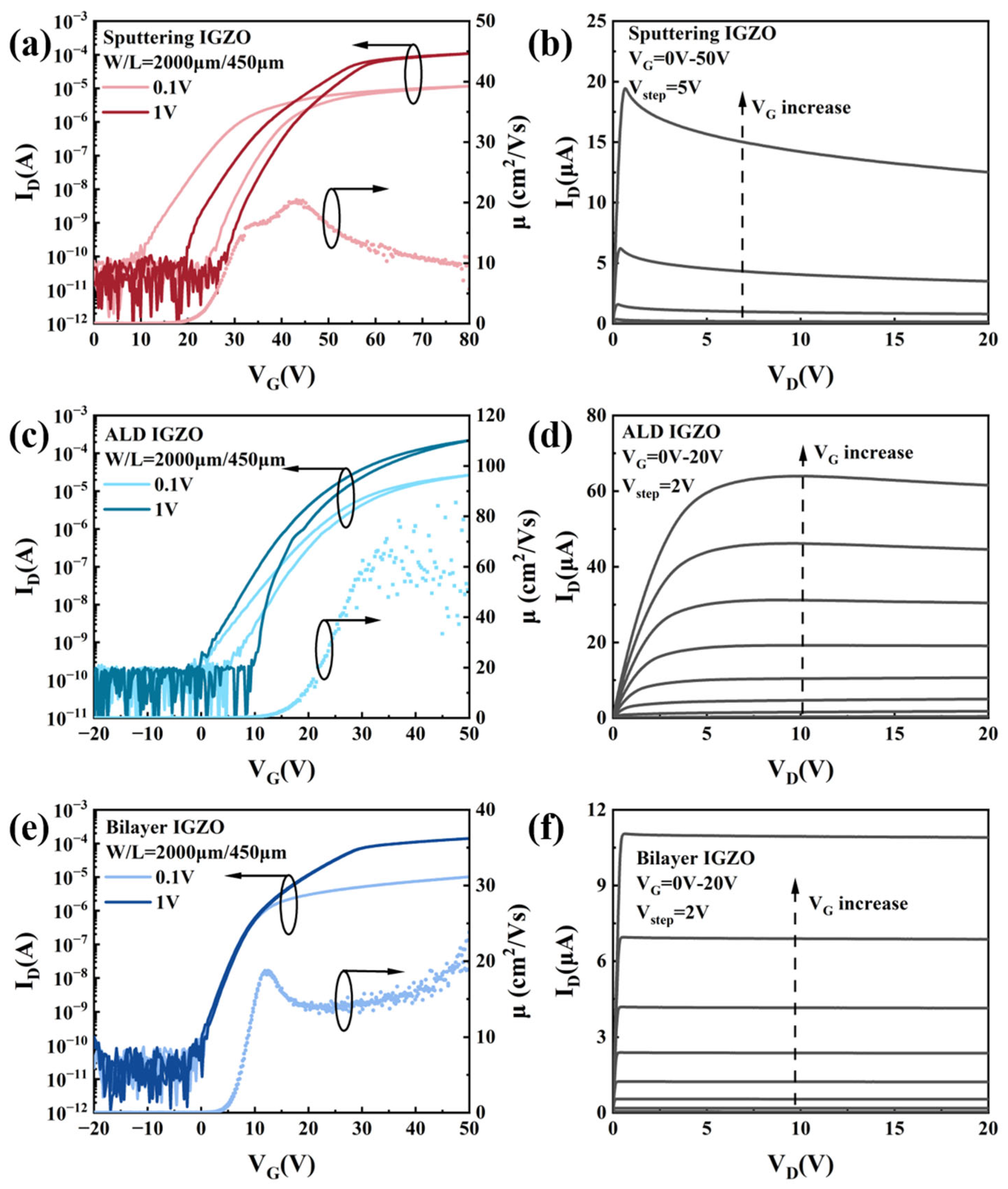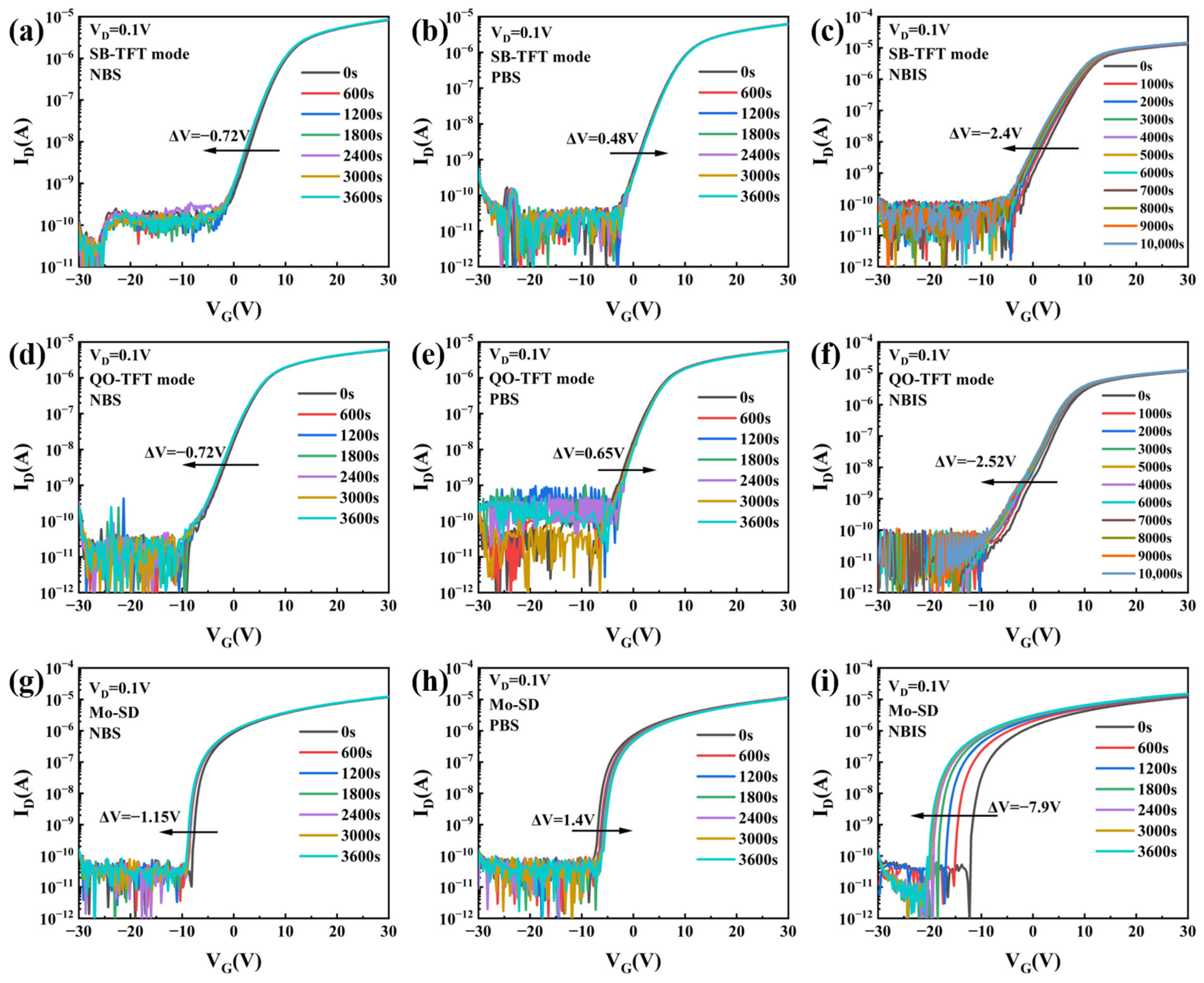Low Saturation Voltage and High Stability in Dual-Mode Schottky Barrier TFTs Using Bilayer IGZO
Abstract
1. Introduction
2. Materials and Methods
3. Results
4. Conclusions
Author Contributions
Funding
Data Availability Statement
Conflicts of Interest
References
- Shannon, J.M.; Balon, F. Source-Gated Thin-Film Transistors. Solid State Electron. 2008, 52, 449–454. [Google Scholar] [CrossRef]
- Sporea, R.A.; Trainor, M.J.; Young, N.D.; Shannon, J.M.; Silva, S.R.P. Intrinsic Gain in Self-Aligned Polysilicon Source-Gated Transistors. IEEE Trans. Electron Devices 2010, 57, 2434–2439. [Google Scholar] [CrossRef]
- Sporea, R.A.; Trainor, M.J.; Young, N.D.; Shannon, J.M.; Silva, S.R.P. Field Plate Optimization in Low-Power High-Gain Source-Gated Transistors. IEEE Trans. Electron Devices 2012, 59, 2180–2186. [Google Scholar] [CrossRef]
- Jiang, C.; Choi, H.W.; Cheng, X.; Ma, H.; Hasko, D.; Nathan, A. Printed Subthreshold Organic Transistors Operating at High Gain and Ultralow Power. Science 2019, 363, 719–723. [Google Scholar] [CrossRef]
- Kim, Y.; Lee, E.K.; Oh, J.H. Flexible Low-Power Operative Organic Source-Gated Transistors. Adv. Funct. Mater. 2019, 29, 1900650. [Google Scholar] [CrossRef]
- Schwarz, M.; Vethaak, T.D.; Derycke, V.; Francheteau, A.; Iniguez, B.; Kataria, S.; Kloes, A.; Lefloch, F.; Lemme, M.; Snyder, J.P.; et al. The Schottky Barrier Transistor in Emerging Electronic Devices. Nanotechnology 2023, 34, 352002. [Google Scholar] [CrossRef]
- Xu, X.; Sporea, R.A.; Guo, X. Source-Gated Transistors for Power- and Area-Efficient AMOLED Pixel Circuits. J. Disp. Technol. 2014, 10, 928–933. [Google Scholar] [CrossRef]
- Huang, S.; Jin, J.; Kim, J.; Wu, W.; Song, A.; Zhang, J. IGZO Source-Gated Transistor for AMOLED Pixel Circuit. IEEE Trans. Electron Devices 2023, 70, 3637–3642. [Google Scholar] [CrossRef]
- Dong, C.; Xu, J.; Zhou, Y.; Zhang, Y.; Xie, H. Light-Illumination Stability of Amorphous InGaZnO Thin Film Transistors in Oxygen and Moisture Ambience. Solid State Electron. 2019, 153, 74–78. [Google Scholar] [CrossRef]
- Mativenga, M.; Haque, F.; Billah, M.M.; Um, J.G. Origin of Light Instability in Amorphous IGZO Thin-Film Transistors and Its Suppression. Sci. Rep. 2021, 11, 14618. [Google Scholar] [CrossRef]
- Zhang, J.; Wilson, J.; Auton, G.; Wang, Y.; Xu, M.; Xin, Q.; Song, A. Extremely High-Gain Source-Gated Transistors. Proc. Natl. Acad. Sci. USA 2019, 116, 4843–4848. [Google Scholar] [CrossRef] [PubMed]
- Li, Y.; Cai, G.; Tang, B.; Zou, S.; Lan, L.; Gong, Z. High-Performance Schottky-Barrier IGZO Thin-Film Transistors Based on Ohmic/Schottky Hybrid Contacts. IEEE Trans. Electron Devices 2024, 71, 6781–6787. [Google Scholar] [CrossRef]
- Zhao, Y.; Wang, Z.; Xu, G.; Cai, L.; Han, T.; Zhang, A.; Wu, Q.; Wang, R.; Huang, T.; Cheng, P.; et al. High Performance Indium-Gallium-Zinc Oxide Thin Film Transistor via Interface Engineering. Adv. Funct. Mater. 2020, 30, 2003285. [Google Scholar] [CrossRef]
- Samanta, S.; Chand, U.; Xu, S.; Han, K.; Wu, Y.; Wang, C.; Kumar, A.; Velluri, H.; Li, Y.; Fong, X.; et al. Low Subthreshold Swing and High Mobility Amorphous Indium–Gallium–Zinc-Oxide Thin-Film Transistor with Thin HfO2 Gate Dielectric and Excellent Uniformity. IEEE Electron Device Lett. 2020, 41, 856–859. [Google Scholar] [CrossRef]
- Cho, M.H.; Seol, H.; Yang, H.; Yun, P.S.; Bae, J.U.; Park, K.-S.; Jeong, J.K. High-Performance Amorphous Indium Gallium Zinc Oxide Thin-Film Transistors Fabricated by Atomic Layer Deposition. IEEE Electron Device Lett. 2018, 39, 688–691. [Google Scholar] [CrossRef]
- Kim, M.J.; Park, H.J.; Yoo, S.; Cho, M.H.; Jeong, J.K. Effect of Channel Thickness on Performance of Ultra-Thin Body IGZO Field-Effect Transistors. IEEE Trans. Electron Devices 2022, 69, 2409–2416. [Google Scholar] [CrossRef]
- Valletta, A.; Mariucci, L.; Rapisarda, M.; Fortunato, G. Principle of Operation and Modeling of Source-Gated Transistors. J. Appl. Phys. 2013, 114, 064501. [Google Scholar] [CrossRef]
- Shannon, J.M.; Gerstner, E.G. Source-Gated Thin-Film Transistors. IEEE Electron Device Lett. 2003, 24, 405–407. [Google Scholar] [CrossRef]
- Shannon, J.M.; Sporea, R.A.; Georgakopoulos, S.; Shkunov, M.; Silva, S.R.P. Low-Field Behavior of Source-Gated Transistors. IEEE Trans. Electron Devices 2013, 60, 2444–2449. [Google Scholar] [CrossRef]
- Lü, Y.-J.; Lin, Z.-J.; Zhang, Y.; Meng, L.-G.; Cao, Z.-F.; Luan, C.-B.; Chen, H.; Wang, Z.-G. Influence of Thermal Stress on the Characteristic Parameters of AlGaN/GaN Heterostructure Schottky Contacts. Chin. Phys. B 2011, 20, 047105. [Google Scholar] [CrossRef]
- Zhao, J.; Lin, Z.; Lu, Y.; Corrigan, T.D.; Meng, L.; Zhang, Y.; Wang, Z.; Chen, H. Influence of Ni Schottky Contact Thickness on Two-Dimensional Electron-Gas Sheet Carrier Concentration of Strained Al0.3Ga0.7N/GaN Heterostructures. J. Semicond. 2010, 31, 084007. [Google Scholar] [CrossRef]
- Bae, S.-H.; Moon, S.-H.; Kwon, Y.H.; Nak-Jin-Seong; Choi, K.-J.; Yoon, S.-M. Synergic Strategies of Composition-Modified Bilayer Channel Configuration and Ozone-Processed Gate Stacks for Atomic-Layer Deposited In-Ga-Zn-O Thin-Film Transistors. J. Alloys Compd. 2022, 906, 164283. [Google Scholar] [CrossRef]
- Lee, S.Y.; Kim, D.H.; Chong, E.; Jeon, Y.W.; Kim, D.H. Effect of Channel Thickness on Density of States in Amorphous InGaZnO Thin Film Transistor. Appl. Phys. Lett. 2011, 98, 122105. [Google Scholar] [CrossRef]
- Hsu, C.-C.; Chen, H.-P.; Ting, W.-C. Correlation between Carrier Concentration Distribution, I-V and C-V Characteristics of a-InGaZnO TFTs. J. Disp. Technol. 2015, 12, 328–337. [Google Scholar] [CrossRef]
- Ko, R.-M.; Wang, S.-J.; Huang, S.-J.; Wu, C.-H.; Chen, W.-H.; Cheng, H.-C. Enhancing Photodetection Performance of UV Photodetectors with Stacked Pt/NiO Dual Capping Layers on IGZO Thin-Film Transistors. AIP Adv. 2023, 13, 075307. [Google Scholar] [CrossRef]
- Zhuang, X.; Kim, J.-S.; Huang, W.; Chen, Y.; Wang, G.; Chen, J.; Yao, Y.; Wang, Z.; Liu, F.; Yu, J.; et al. High-Performance and Low-Power Source-Gated Transistors Enabled by a Solution-Processed Metal Oxide Homojunction. Proc. Natl. Acad. Sci. USA 2023, 120, e2216672120. [Google Scholar] [CrossRef]
- Bestelink, E.; Zschieschang, U.; Askew, L.; Klauk, H.; Sporea, R.A. Organic Source-Gated Phototransistors with > 104 Photo-To-Dark Current Ratio in the Visible Range at Zero Gate-Source Bias. Adv. Opt. Mater. 2024, 12, 2301931. [Google Scholar] [CrossRef]
- Bestelink, E.; Zschieschang, U.; Bandara, R.M.I.; Klauk, H.; Sporea, R.A. The Secret Ingredient for Exceptional Contact-Controlled Transistors. Adv. Electron. Mater. 2022, 8, 2101101. [Google Scholar] [CrossRef]
- Zhu, Q.; Huang, Y.; Wu, J.; Guo, M.; Ou, H.; Liu, B.; Lu, X.; Chen, J.; Liang, X.; Wu, Q.; et al. Enhanced Performance and Stability of Atomic Layer Deposited In₂O₃ Transistors With Multi-Function Cation-Doped ZnSnO Layers. IEEE Electron Device Lett. 2024, 45, 845–848. [Google Scholar] [CrossRef]
- Park, J.C.; Lee, H.-N. Improvement of the Performance and Stability of Oxide Semiconductor Thin-Film Transistors Using Double-Stacked Active Layers. IEEE Electron Device Lett. 2012, 33, 818–820. [Google Scholar] [CrossRef]
- Hong, S.; Park, J.W.; Kim, H.J.; Kim, Y.; Kim, H.J. A Review of Multi-Stacked Active-Layer Structures for Solution-Processed Oxide Semiconductor Thin-Film Transistors. J. Inf. Disp. 2016, 17, 93–101. [Google Scholar] [CrossRef]
- Guo, M.; Ou, H.; Xie, D.; Zhu, Q.; Wang, M.; Liang, L.; Liu, F.; Ning, C.; Cao, H.; Yuan, G.; et al. Critical Assessment of the High Carrier Mobility of Bilayer In2O3/IGZO Transistors and the Underlying Mechanisms. Adv. Electron. Mater. 2023, 9, 2201184. [Google Scholar] [CrossRef]
- Raj, R.B.; Tripathi, A.K.; Mahato, P.K.; Nair, S.; Deepak; Shahana, T.K.; Mukundan, T. Effect of Active Layer Thickness Variation on Scaling Response in A-IGZO Thin Film Transistors under Schottky Limited Operation. Semicond. Sci. Technol. 2021, 36, 115007. [Google Scholar] [CrossRef]
- Li, Y.; Zhou, Y.; Zou, S.; Lan, L.; Gong, Z. Insight into the Evolution of Electrical Properties for Schottky-Barrier IGZO Thin-Film Transistors with Cu-Based Schottky Contacts. Appl. Phys. Lett. 2023, 123, 103503. [Google Scholar] [CrossRef]
- Sporea, R.A.; Niang, K.M.; Flewitt, A.J.; Silva, S.R.P. Novel Tunnel-Contact-Controlled IGZO Thin-Film Transistors with High Tolerance to Geometrical Variability. Adv. Mater. 2019, 31, 1902551. [Google Scholar] [CrossRef]
- Tu, Y.-F.; Huang, J.-W.; Chang, T.-C.; Hung, Y.-H.; Tai, M.-C.; Chen, J.-J.; Lin, S.-K.; Zhou, K.-J.; Chien, Y.-T.; Huang, H.-C.; et al. Stably Saturated Output Current Characteristics and Hot-Carrier Reliability of a-InGaZnO Thin-Film Transistors With Source-Connected Field Plate. IEEE Trans. Electron Devices 2023, 70, 4669–4673. [Google Scholar] [CrossRef]
- Bestelink, E.; Niang, K.M.; Wyatt-Moon, G.; Flewitt, A.J.; Sporea, R.A. Promoting Low-Voltage Saturation in High-Performance a-InGaZnO Source-Gated Transistors. IEEE Trans. Electron Devices 2024, 71, 581–587. [Google Scholar] [CrossRef]
- Lee, D.-H.; Kwon, Y.-H.; Seong, N.-J.; Choi, K.-J.; Kim, G.; Yoon, S.-M. Analysis on Contact Resistance and Effective Channel Length of Thin Film Transistors Using Composition-Modified In–Ga–Zn-O Active Channels Prepared with Atomic Layer Deposition and Various Electrode Materials. ACS Appl. Electron. Mater. 2022, 4, 6215–6228. [Google Scholar] [CrossRef]
- Chen, Q.; Wang, L.; Duan, X.; Guo, J.; Wang, Z.; Huang, K.; Feng, J.; Sun, Y.; Jiao, G.; Jing, W.; et al. Investigation of Asymmetric Characteristics of Novel Vertical Channel-All-Around (CAA) In-Ga-Zn-O Field Effect Transistors. IEEE Electron Device Lett. 2022, 43, 894–897. [Google Scholar] [CrossRef]
- Wang, G.; Zhuang, X.; Huang, W.; Yu, J.; Zhang, H.; Facchetti, A.; Marks, T.J. New Opportunities for High-Performance Source-Gated Transistors Using Unconventional Materials. Adv. Sci. 2021, 8, 2101473. [Google Scholar] [CrossRef]
- Conley, J.F. Instabilities in Amorphous Oxide Semiconductor Thin-Film Transistors. Ieee Trans. Device Mater. Reliab. 2010, 10, 460–475. [Google Scholar] [CrossRef]
- Shannon, J.M. Stable Transistors in Hydrogenated Amorphous Silicon. Appl. Phys. Lett. 2004, 85, 326–328. [Google Scholar] [CrossRef]






| Channel | μ (cm2/Vs) | IDSAT (μA) | VDSAT (V) | dVDSAT/dVG | Reference |
|---|---|---|---|---|---|
| Sputtering IGZO | 10 | 13 @VG = 50 V | 0.65 @VG = 50 V | ~0.04 | This work |
| ALD IGZO | 45 | 60 @VG = 20 V | 7.5 @VG = 20 V | ~0.6 | This work |
| Bilayer IGZO | 20 | 11 @VG = 20 V | 0.4 @VG = 20 V | ~0.036 | This work |
| Sputtering IGZO | - | 34 @VG = 40 V | <3 @VG = 40 V | ~0.1 | [11] |
| Sputtering IGZO | - | 0.7 @VG = −8.4 V | 3 @VG = −8.4 V | 0.12 | [35] |
| Sputtering IGZO | - | 2.7 @VG = 10 V | 3 @VG = 10 V | ~0.4 | [36] |
| Sputtering IGZO | 4.5 | 11 @VG = 20 V | 2.7 @VG = 20 V | 0.12 | [37] |
| ALD IGZO | 2.8 | 5.4 @VG = 10 V | - | - | [38] |
| ALD IGZO | - | 23 @VG = 1 V | 0.6 @VG = 1 V | - | [39] |
| Mo-SD | SB-TFT Mode | QO-TFT Mode | |
|---|---|---|---|
| VD(V) | 0.1 | 0.1 | 0.1 |
| ΔVNBS (V) | −1.15 | −0.72 | −0.72 |
| ΔVPBS (V) | 1.4 | 0.65 | 0.48 |
| ΔVNBIS (V) | −7.9 | −1.44 | −1.68 |
Disclaimer/Publisher’s Note: The statements, opinions and data contained in all publications are solely those of the individual author(s) and contributor(s) and not of MDPI and/or the editor(s). MDPI and/or the editor(s) disclaim responsibility for any injury to people or property resulting from any ideas, methods, instructions or products referred to in the content. |
© 2025 by the authors. Licensee MDPI, Basel, Switzerland. This article is an open access article distributed under the terms and conditions of the Creative Commons Attribution (CC BY) license (https://creativecommons.org/licenses/by/4.0/).
Share and Cite
Huang, Y.; Liang, X.; Zhang, L.; Wang, M.; Wang, T.; Liu, C. Low Saturation Voltage and High Stability in Dual-Mode Schottky Barrier TFTs Using Bilayer IGZO. Electronics 2025, 14, 1380. https://doi.org/10.3390/electronics14071380
Huang Y, Liang X, Zhang L, Wang M, Wang T, Liu C. Low Saturation Voltage and High Stability in Dual-Mode Schottky Barrier TFTs Using Bilayer IGZO. Electronics. 2025; 14(7):1380. https://doi.org/10.3390/electronics14071380
Chicago/Turabian StyleHuang, Yi, Xiaoci Liang, Li Zhang, Mengye Wang, Tianyue Wang, and Chuan Liu. 2025. "Low Saturation Voltage and High Stability in Dual-Mode Schottky Barrier TFTs Using Bilayer IGZO" Electronics 14, no. 7: 1380. https://doi.org/10.3390/electronics14071380
APA StyleHuang, Y., Liang, X., Zhang, L., Wang, M., Wang, T., & Liu, C. (2025). Low Saturation Voltage and High Stability in Dual-Mode Schottky Barrier TFTs Using Bilayer IGZO. Electronics, 14(7), 1380. https://doi.org/10.3390/electronics14071380






